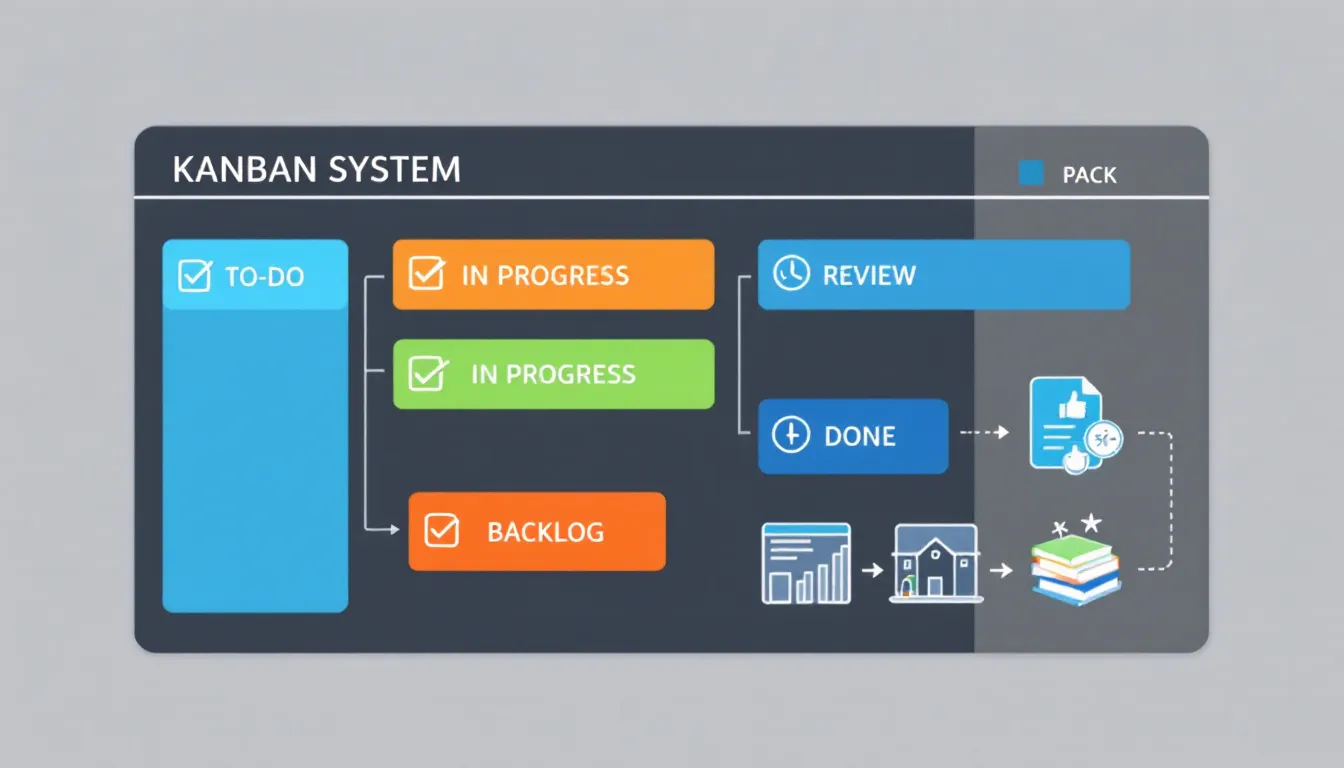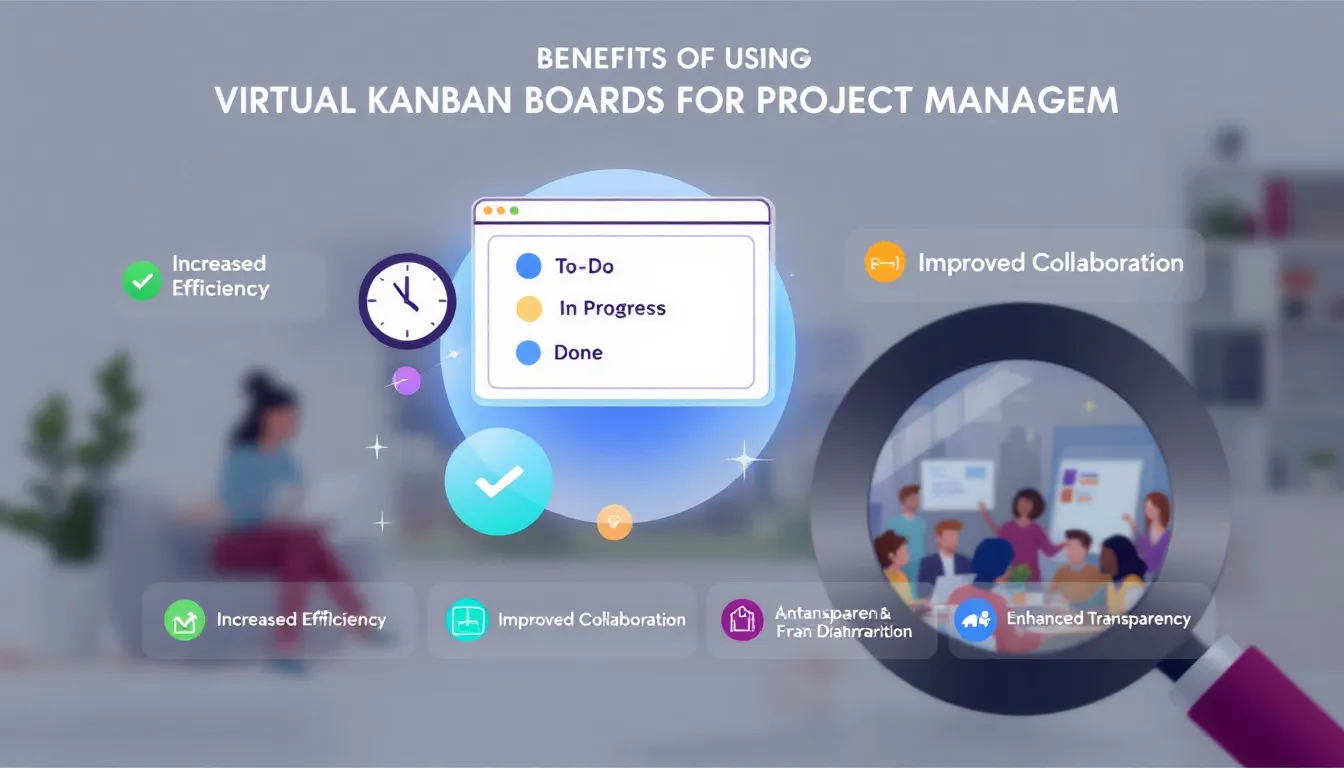Kanban helps make software development projects more effective by reducing bottlenecks and improving task management. By visualizing tasks and workflow, Kanban provides teams with clarity and efficiency. In this article, we’ll explore the benefits of Kanban for software development projects and how it can enhance your project management.
Enhancing Team Efficiency with Kanban

Kanban significantly enhances team efficiency by visually managing workloads and swiftly identifying process bottlenecks. By using a basic Kanban board, software development teams can clearly see tasks at various stages—what’s completed, in progress, or pending—allowing for improved transparency and coordination. This visualization, particularly when utilizing physical boards and Kanban cards, enables team members to effectively manage workflow, shift smoothly from inefficient push-based task assignments to dynamic pull workflows, and balance workloads based on capacity and priorities. As a result, teams experience reduced overload, minimized multitasking, and faster task completion.
Furthermore, Kanban emphasizes continuous process improvement and workload management through key principles like regularly adjusting priorities and limiting work in progress (WIP). Setting clear WIP limits prevents multitasking and ensures tasks are completed thoroughly before initiating new ones, thereby reducing bottlenecks and process waste. Regular evaluations and priority adjustments empower teams to consistently focus on critical tasks, driving productivity gains, optimizing workflows, and creating a more efficient and responsive working environment.
Overall, the Kanban methodology offers numerous benefits for enhancing team efficiency through lean methodology. Here are some key advantages:
- Enhances visual clarity
- Shifts workflows to a pull system
- Empowers process improvements
- Limits work in progress
These features help software development teams work more effectively and deliver higher-quality results.
Visualizing Workflows

Visualizing workflows is central to the Kanban framework, enabling teams to clearly map task progression stages through structured Kanban boards. Columns represent each stage, while features like swimlanes categorize tasks, enhancing transparency, organization, and communication. Color-coded Kanban cards further clarify task types—such as development, testing, or bug fixes—making it simpler for team members to prioritize and manage their workloads efficiently.
Moreover, visual metrics like Cumulative Flow Diagrams (CFDs) provide deeper insights into workflow dynamics by highlighting task movement and pinpointing bottlenecks promptly. Virtual Kanban boards extend these benefits, especially for distributed teams, offering real-time tracking, dynamic updates, and effective remote collaboration. Collectively, these visual tools and practices help teams align efforts, swiftly address challenges, and consistently achieve improved productivity and workflow management.
Limiting Work in Progress (WIP)
Limiting work in progress (WIP) is a fundamental Kanban principle designed to optimize productivity by controlling the number of tasks active at any one time. By setting clear WIP limits—represented by the maximum number of Kanban cards allowed in a given column—teams avoid overwhelming multitasking, reduce unfinished task accumulation, and improve task completion speed and quality. This focused approach enhances resource allocation and ensures that team members concentrate effectively on their immediate tasks, promoting greater efficiency.
Regularly reviewing and adjusting WIP limits according to team capacity and task complexity is essential for maintaining workflow efficiency. Tailoring WIP limits to specific work requirements allows teams, particularly those handling complex tasks, to give each assignment appropriate attention and resources. Continuous evaluation and adjustment of these limits help detect bottlenecks early, facilitate smoother workflows, and foster sustained productivity improvements within the team.
Managing Flow Effectively
Effective flow management is critical to Kanban’s success, enabling teams to visualize workflows clearly and swiftly identify bottlenecks. By mapping tasks and their stages visually, teams can quickly recognize interruptions and address them promptly, ensuring continuous and efficient workflow. Setting appropriate WIP limits further aids in maintaining this focus, reducing cycle times, and optimizing resources to enhance overall productivity.
Additionally, effective flow management accelerates task completion, directly improving customer satisfaction through quicker deliverables. Digital Kanban tools support this effort by providing insights into lead times, cycle durations, and process phases, empowering teams to analyze workflow efficiency and pinpoint improvement areas. Leveraging these strategies—visualizing workflows, optimizing WIP limits, and utilizing digital tracking tools—helps teams maintain a smooth, uninterrupted workflow, enhancing efficiency and aligning closely with Kanban’s core principles.
Continuous Improvement
Continuous improvement is foundational to the Kanban framework, fostering a culture of regular evaluation and enhancement. Feedback loops, retrospective meetings, and critical metrics like lead time and cycle time empower teams to identify inefficiencies, make data-driven decisions, and continuously optimize workflows. Regularly tracking these metrics provides insights into performance, highlighting areas where adjustments can reduce delays and increase productivity.
To prevent workflow stagnation, Kanban encourages teams to maintain flexibility and focus on delivering overall value, rather than narrowly fixating on isolated metrics. Collaborative retrospectives enable team members to openly discuss experiences, propose improvements, and drive actionable changes, ensuring continuous progress toward project goals. By adopting these incremental improvement practices, teams consistently enhance their processes, efficiency, and ability to deliver meaningful outcomes.
Flexibility and Adaptability
Kanban's flexibility and adaptability are key strengths, particularly valuable in software development projects. Its ability to accommodate adjustments without disrupting ongoing work allows teams to continuously refine processes seamlessly. By respecting existing workflows and structures, Kanban integrates smoothly into current practices, minimizing disruptions and enabling gradual improvements tailored to specific team needs.
Additionally, Kanban empowers team members by fostering ownership, accountability, and collaboration at all levels. Encouraging individuals to manage their tasks and leverage their expertise creates an engaged and adaptable team environment. This empowerment facilitates proactive decision-making and continuous adaptation, further enhancing efficiency, productivity, and the overall success of software development initiatives.
Enhanced Collaboration and Communication
Kanban significantly enhances team collaboration and communication by visually representing workflows, clearly defining tasks, and fostering transparency. Open access to Kanban boards allows team members to easily understand each other’s responsibilities and workloads, creating shared accountability and a culture of mutual support. Real-time updates, especially through virtual Kanban tools, enable teams to promptly address issues, synchronize tasks between technical and non-technical members, and facilitate seamless cross-functional collaboration, ultimately driving more efficient project outcomes.
Benefits of Using Virtual Kanban Boards

Virtual Kanban boards deliver significant advantages for software development teams, particularly those working remotely. These boards visually represent task progression in real-time, enabling seamless collaboration, clearer communication, and enhanced responsiveness across distributed teams. Immediate visibility into workflow changes helps team members quickly address delays or obstacles, maintaining momentum and ensuring projects remain on schedule.
Furthermore, virtual Kanban boards integrate effortlessly with popular project management tools like Jira or Trello, enhancing their functionality and streamlining workflows. Such integration minimizes manual updates, provides a comprehensive overview of tasks, and ensures teams always have access to current, accurate project data. As a result, virtual Kanban boards empower teams to collaborate effectively, manage tasks efficiently, and achieve their project goals more reliably.
Implementing Kanban in Software Development Teams
Implementing Kanban in software development teams involves mapping existing workflows onto a Kanban board, facilitating a seamless transition without disrupting current processes. Clearly defined policies for task prioritization and card movement support consistent, empowered decision-making. Additionally, fostering open communication through regular meetings ensures alignment around shared responsibilities, while leveraging virtual Kanban boards enhances real-time visibility, effective collaboration, and streamlined workflows—particularly valuable for distributed teams—ultimately driving improved efficiency and productivity.
Common Challenges and Solutions
Adopting Kanban in software development teams can pose challenges such as balancing daily task execution with continuous improvement, managing resistance to cultural change, preventing Kanban board overload, and effectively transitioning from push to pull workflows. Successfully overcoming these issues involves fostering a supportive organizational culture, securing leadership commitment, clearly defining process policies and prioritization guidelines, maintaining manageable WIP limits, and empowering team members through trust and training. By addressing these areas proactively, teams can smoothly implement Kanban, ultimately achieving enhanced productivity, clarity, and collaborative success.
Final thoughts
Kanban is a transformative framework for software development teams, significantly enhancing productivity, workflow clarity, and collaboration. By visualizing tasks, effectively managing workflow, setting appropriate limits on work in progress, and embracing continuous improvement, teams can optimize efficiency and responsiveness. Kanban's flexibility allows seamless integration into dynamic environments, while virtual boards foster stronger communication among distributed teams. Although implementing Kanban requires thoughtful planning and ongoing adjustment, its ability to empower teams, streamline processes, and deliver consistent, high-quality results makes it a highly valuable methodology for achieving lasting success in software development.



